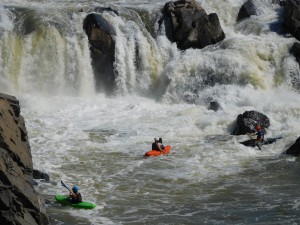“The Great Falls are actually a series of cascades and rapids on a two-thirds of a mile stretch of the Potomac. The river drops about 76 feet over this distance. None of the individual falls exceeds a 20 foot drop.”
—Maryland Geological Survey
They may not rival Niagara Falls, but the Great Falls of the Potomac River are still quite a sight, especially when the river is at flood stage. First-time visitors are amazed to find such a treasure only 10 miles from Washington, D.C. Long-time visitors are just ever grateful that it’s here.
Both Maryland and Virginia share views of the falls at two different but complementary national parks. The park on the Virginia side is called Great Falls Park. The park on the Maryland side is part of the C&O Canal National Historical Park, which extends along the Potomac for over 180 miles. People commonly refer to this section of the park as Great Falls, Maryland.
If you stand at the Great Falls overlook on the Maryland side, you can easily see people at the overlooks on the Virginia side, less than 500 feet away. But to get from here to there, you have to drive south to I-495, cross the river on the American Legion Bridge, and then head back north on Georgetown Pike, about a 13-mile or half-hour drive.
It’s worth visiting both parks for their strikingly different views of Great Falls and for other features you can only find at one park or the other. So here’s a brief comparison of the two Great Falls parks.
Getting In
Both parks charge entrance fees ($20 per car, $10 for walk-ins or cyclists), good for seven days. The fee you pay at one park covers admission to the other as well. There’s no fee for people who walk or bike into the park on the Maryland side via the towpath or other trails. It’s possible to walk into the park on the Virginia side as well, but that park is not as readily accessible by trail.
Both parks sell various kinds of park passes at their entrance stations. However, the station in Maryland is often unmanned due to staffing shortages, and this tends to frustrate visitors hoping to buy a pass there. The entrance station in Virginia is more reliably staffed.
Both parks have huge parking areas, but they can fill up on busy days. On weekends and holidays, you will often have to wait in a long line of cars to get in.
Visitor Centers
The Maryland visitor center is in Great Falls Tavern, a historic building dating from 1831. It has an information desk and some graphic exhibit panels and low-tech, touchable exhibits that give a basic overview of the park and the canal. You used to be able to buy books, calendars, tee-shirts, and other items here, but that was discontinued during the pandemic and hasn’t returned yet. [Update: The sales area has reopened!]
The Virginia visitor center building probably dates from the 1960s. It’s bigger and more elaborate inside than Great Falls Tavern. As I recall, it has lots of interesting exhibits, a theater presentation, a shop, and an information desk. But as of this writing, it is closed for renovation.


Other Amenities
Neither park has much in the way of food service. You may find a food truck at the Maryland park on weekends, but the refreshment stand that was once there is closed. I don’t know of any food services on the Virginia side.
But you can certainly picnic! Here, the Virginia park excels. It has dozens of picnic tables spread across a broad area, some with a distant view of the falls. The Maryland park has only a few picnic tables, most in a small area tucked between the parking lot and the canal.
The C&O Canal National Historical Park is “trash free,” meaning you won’t even find a bottle of water for sale or a trash can to discard one in. You can obtain plastic bags here for packing out your trash. There are trash cans throughout the Virginia park.
Historic Structures
Maryland, of course, has the C&O Canal. A closely spaced series of six locks were built here in the early 1800s to route the canal around Great Falls. Four of those locks remain operational. This allows park staff to keep a section of the canal here watered, demonstrate lock operations, and provide rides on a replica canal boat. Presently, the canal has been drained for dredging and other maintenance work, so there are no boat rides for now. Other historic structures here include Great Falls Tavern and the remains of nearby lockhouses.
Great Falls in Maryland is also the starting point for the Washington Aqueduct, built in the mid-1800s to supply the city of Washington with water. It is still operational, and there are structures here relating to it as well. The surrounding woods were the site of several gold mines, although few identifiable traces of them remain.
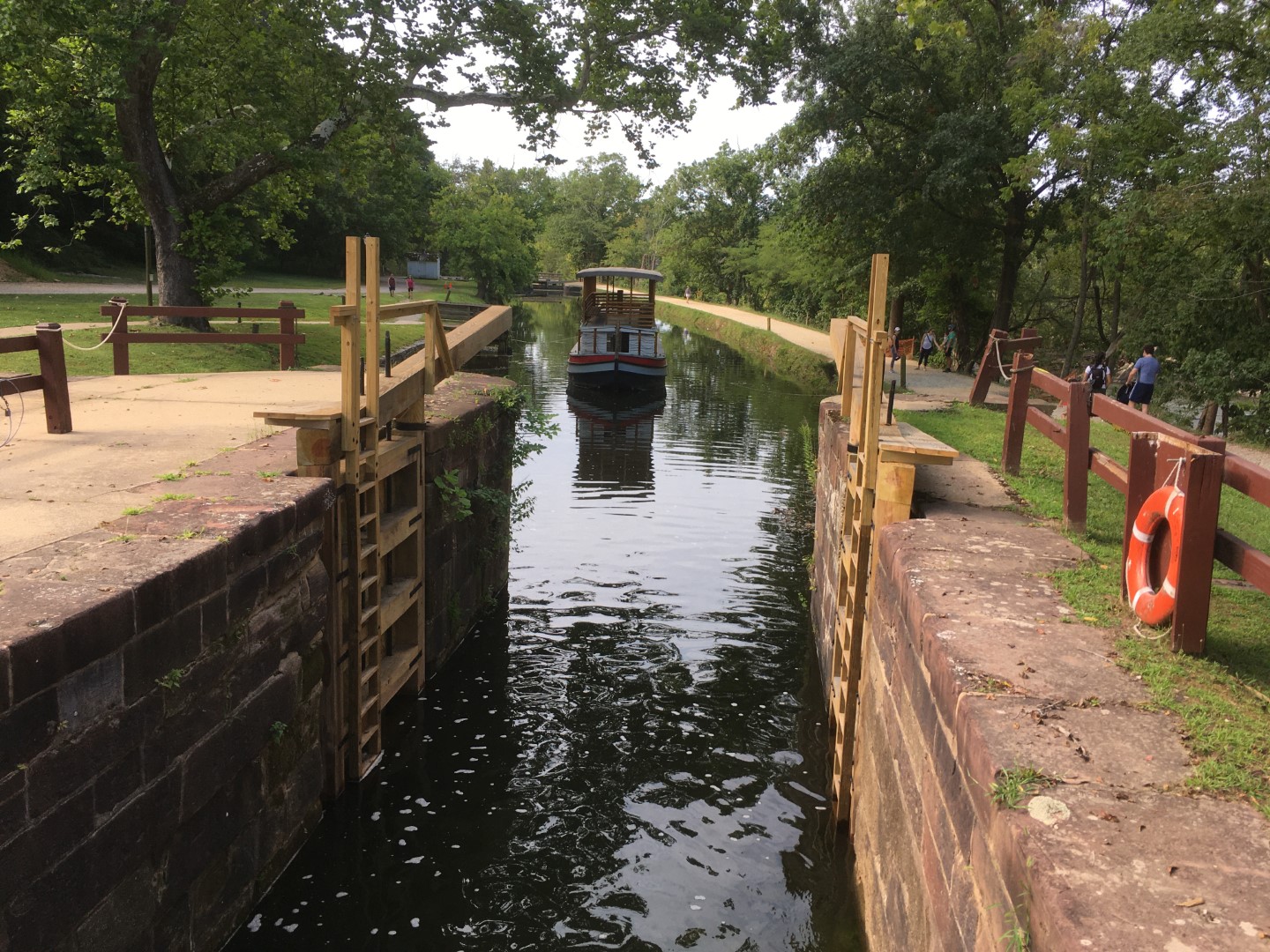




Great Falls in Virginia has the remains of another, older canal: the Patowmack Canal. Before he became our first president, George Washington led an effort to improve navigation on the Potomac by building a series of five canals around the roughest stretches of the river. The most difficult and complex canal was the one built to skirt Great Falls. You can walk the length of it today and see the remains of some of its locks and other structures. But there is much less left of the Patowmack Canal than the C&O Canal.
Scenic Vistas
Virginia has the edge here, but Maryland offers some spectacular vistas as well. The best is from the Great Falls Overlook (below), a half-mile walk from Great Falls Tavern. A boardwalk trail leads from the canal towpath, over some rushing torrents, and across Olmstead Island to the overlook. When the Potomac is at flood stage, river waters pour beneath the boardwalk through several channels. If the river level gets too high, park rangers have to close the trail.


A little farther down the towpath past the overlook trail is an outstanding view of a looping side channel from a high escarpment known as Mary’s Wall. This too provides an impressive view during a major flood. The two pairs of pictures below were taken from the same stretch of the towpath above Mary’s Wall.

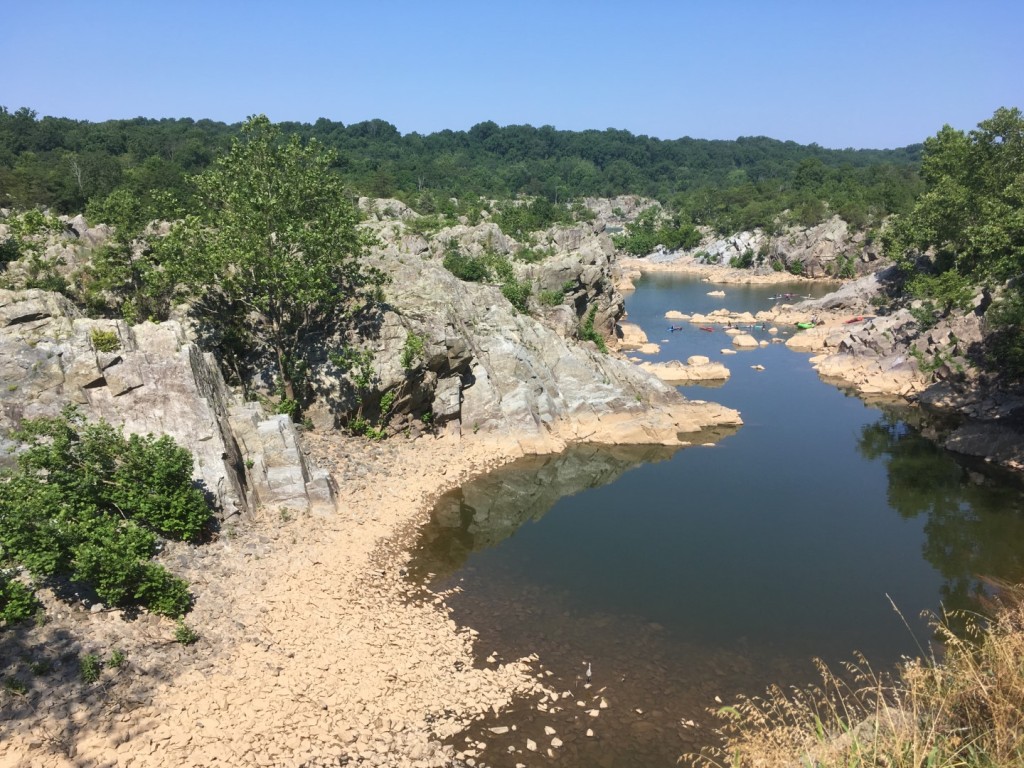

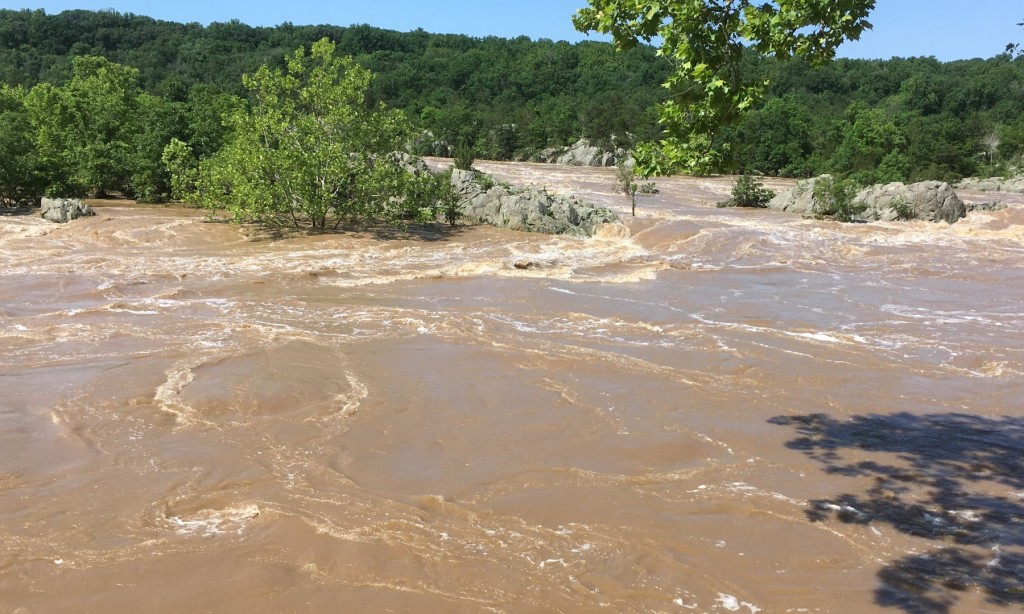
In Virginia you can walk to a series of overlooks just a short distance from the visitor center. Here you see the river and falls head-on, a spectacular sight. You can sometimes watch expert kayakers dropping down one of the falls here into the river below. Hiking trails lead to other views of the river and Mather Gorge downstream from the falls.
The two photos below were taken from those easy to access overlooks. You can see the Maryland overlook atop the cliff at the right edge of the June 2023 photo.

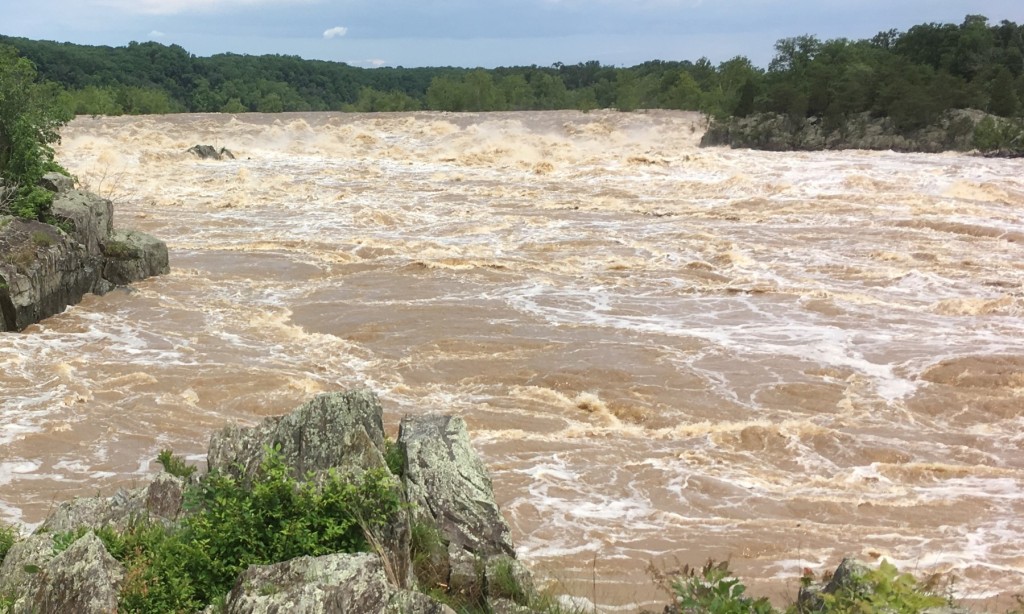
Trails
In Maryland, the C&O Canal towpath at Great Falls is part of an unbroken trail corridor that extends via the canal towpath from Washington, D.C., to Cumberland, Maryland, and then via the Great Allegheny Passage to Pittsburgh, Pennsylvania. That’s hard to beat. You will often run across bicyclists here who have pedaled all the way from Pittsburgh or Cumberland.
The Maryland side has lots of other hiking trails of varying degrees of difficulty: in the woods through former gold mine areas, beside the river upstream from the falls, and along Mather Gorge via the rugged Billy Goat trail. The trails at Great Falls are part of a network that extends for several miles downstream to the Widewater and Carderock areas of the park. They offer almost limitless options for loop hikes of widely varying length and difficult.


I’m less familiar with the trail system on the Virginia side. I’ve often walked the easier trails that follow the river and the old canal. But there is also the rockier River Trail, which follows Mather Gorge, and other trails through the adjacent woods that follow ridge or stream. You can bike or ride a horse on some of the trails, but cycling isn’t as popular here as on the Maryland side. I can’t recall ever seeing a bicyclist here.
Wildlife
My best wildlife sighting at the Virginia park was a fox, way too acclimated to people, that approached me and Sue much too closely on a trail once. But admittedly, I haven’t spent as much time here as I have on the Maryland side.
I’ve had countless impressive wildlife sightings at or near Great Falls: herons, egrets, owls, eagles, snapping turtles and other turtles and snakes, deer, foxes, racoons, beavers, muskrats, otters. A rare sighting of a brilliantly colored male painted bunting attracted swarms of serious birders from around the region to the park in January 2021. You never know what you’ll see on a given day along the C&O Canal.
In Conclusion
Both parks are well worth visiting. Come to Virginia for the extraordinary views and to Maryland for the C&O Canal, but also take advantage of everything else these parks have to offer. I’ve visited both parks countless times over many decades, and I never tire of returning.
Park Websites
C&O Canal National Historical Park
Related Posts
A Trail Guide to Great Falls in Maryland
Gold Mines at Great Falls in Maryland
David Romanowski, 2023

